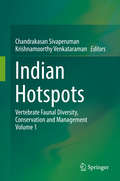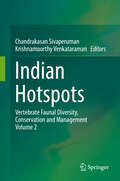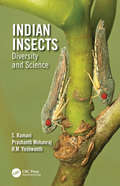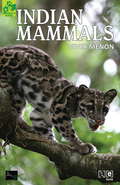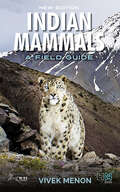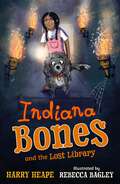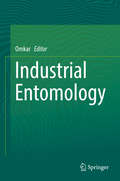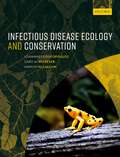- Table View
- List View
An Indian Elephant and its Mahout Driver (UEB uncontracted)
by RnibThis image shows a man riding an elephant in the centre of the page. On the left of the page is a pile of logs. There is a locator dot shown, which will be at the top left of the page when the image is the correct way up. The elephant and the man are shown from the side, facing to the left so only one eye is shown on each of them. The elephant's head is in the centre of the page. Its eye is in the middle of the head. To the right is the elephant's large ear. Down from the eye is the trunk which curls down and to the right nearly to the ground. To the right of the trunk is one its two tusks. The sharp end of the tusk has been removed for safety reasons and is capped with a metal cup. Wedged between the elephant's trunk and its tusk is the round end of a large log the elephant is carrying. In the bottom left of the page is a pile of ten logs. Nine of them are shown end-on like the one the elephant is carrying. One is shown side-on resting diagonally on the other logs. To the right of the logs are the elephant's four thick sturdy legs. Up from the legs is its large body. Sitting on top of the elephant between its shoulders and back is a man. This is the elephant's mahout, the person who controls and looks after the elephant. Only one of his arms and legs are shown. He wears a red tee shirt and blue shorts. The rest of his leg is bare and he has no shoes. He holds a long stick, used to control the elephant. On the right of the page the elephant's tail hangs down from its bottom. It has a hairy end.
Indian Hotspots: Vertebrate Faunal Diversity, Conservation and Management Volume 1
by Chandrakasan Sivaperuman Krishnamoorthy VenkataramanThis book offers a comprehensive account of India’s four biodiversity hotspots: the Himalaya, Indo-Burma, Western Ghats and Sri Lanka and Andaman and Nicobar Islands. With a focus on tropical rainforests, it includes more than 30 chapters covering different vertebrate fauna e.g. fishes, amphibians, reptiles, birds, and mammals, as well as topics such as conservation and management aspects. Written by experts in the field of biodiversity conservation and management, it offers ample new insights into a number of subjects related to the faunal communities of tropical forest ecosystems, providing a valuable resource for conservationists and researchers in the field of flora and fauna diversity.
Indian Hotspots: Vertebrate Faunal Diversity, Conservation and Management Volume 2
by Chandrakasan Sivaperuman Krishnamoorthy VenkataramanThis book offers a comprehensive account of India’s four biodiversity hotspots: the Himalaya, Indo-Burma, Western Ghats and Sri Lanka and Andaman and Nicobar Islands. With a focus on tropical rainforests, it includes more than 30 chapters covering different vertebrate fauna e.g. fishes, amphibians, reptiles, birds, and mammals, as well as topics such as conservation and management aspects.Written by experts in the field of biodiversity conservation and management, it offers ample new insights into a number of subjects related to the faunal communities of tropical forest ecosystems, providing a valuable resource for conservationists and researchers in the field of flora and fauna diversity.
Indian Insects: Diversity and Science
by S. Ramani Prashanth Mohanraj Yeshwanth HmInsects are the most interesting and diverse group of organisms on earth, many of which are useful as pollinators of crops and wild plants while others are useful as natural enemies keeping pestiferous insects in check. It is important to conserve these insects for our survival and for this the diversity of insect species inhabiting the different ecosystems of our country must be known. The cornerstone to studies of any kind of organismal diversity is their taxonomic identity. Even after over two and half centuries of studies, so little is known of the insect wealth of our country. It has contributions from taxonomists who have been studying Indian insects for long, this book offers up to date information on many important groups of Indian insects seeking to fill the lacuna of a long felt need for a comprehensive work on the taxonomy of Indian insects. Salient features: Provides an up-to-date taxonomy of major insect groups of India Presents identification keys with illustrations of several important groups of Indian insects Gives a new insight into why insects are so abundant Addresses fundamental questions in mechanoreception and cross kingdom interactions using insects as model systems Indian Insects: Diversity and Science is a festschrift to Professor C. A. Viraktamath, an insect taxonomist par excellence. It has been designed to cater to the needs of academicians, researchers and students who wish to identify insects collected from local environments and will be an invaluable aid for those working in the areas of systematics, ecology, behaviour, diversity and the conservation of insects.
Indian Insects: Diversity and Science
by S. Ramani Prashanth Mohanraj Yeshwanth HmInsects are the most interesting and diverse group of organisms on earth, many of which are useful as pollinators of crops and wild plants while others are useful as natural enemies keeping pestiferous insects in check. It is important to conserve these insects for our survival and for this the diversity of insect species inhabiting the different ecosystems of our country must be known. The cornerstone to studies of any kind of organismal diversity is their taxonomic identity. Even after over two and half centuries of studies, so little is known of the insect wealth of our country. It has contributions from taxonomists who have been studying Indian insects for long, this book offers up to date information on many important groups of Indian insects seeking to fill the lacuna of a long felt need for a comprehensive work on the taxonomy of Indian insects. Salient features: Provides an up-to-date taxonomy of major insect groups of India Presents identification keys with illustrations of several important groups of Indian insects Gives a new insight into why insects are so abundant Addresses fundamental questions in mechanoreception and cross kingdom interactions using insects as model systems Indian Insects: Diversity and Science is a festschrift to Professor C. A. Viraktamath, an insect taxonomist par excellence. It has been designed to cater to the needs of academicians, researchers and students who wish to identify insects collected from local environments and will be an invaluable aid for those working in the areas of systematics, ecology, behaviour, diversity and the conservation of insects.
Indian Mammals: A Field Guide
by Vivek MenonAn invaluable reference and exceptionally usable guide to the mammals of India Covering the rich diversity of mammal species in India, from tigers, elephants, rhinos and whales to primates, rodents and bats, Indian Mammals is a comprehensive, field-ready and illustrated guide. Accompanied by superb full-colour photographs, supplementary illustrations and distribution maps, and based on impeccable scientific research reviewed by experts, Indian Mammals records details of virtually every mammal known to exist in India. The in-depth, up-to-date text by Vivek Menon, one of India's leading naturalists and an authority on Indian wildlife, describes key identification features, biometrics, behaviour, social strategies, habitat and distribution. Encyclopaedic in sweep yet accessible in approach, Indian Mammals includes the majestic and most sought after as well as the extraordinary and elusive mammals. Passionate wildlife watchers will appreciate the range of coverage and tips on identifying mammals, while naturalists will value the exacting detail needed to distinguish similar species in the field. Planned for easy reference, this compact guide is the essential resource for wildlifers of any age, from animal watchers and eco-tourists to active conservationists. • More than 400 species of both land and water mammals with introductory pages on each order • Over 1,000 carefully curated photographs • Nearly 150 distribution maps • Colour tabs for sections to facilitate ease of use • The full index doubles up as a life-list • Field notes reveal uncommon on-site experiences
Indian Mammals: A Field Guide
by Vivek MenonA fully updated edition of the bestselling guide to the mammals of IndiaCovering the rich diversity of mammal species in India, from tigers, elephants, rhinoceros and whales to primates, rodents and bats, Indian Mammals is field-ready, illustrated and comprehensive in approach. Rigorously researched, Indian Mammals reflects a lifetime's work by Vivek Menon, one of India's leading authorities on Indian wildlife. Planned for easy reference, this compact guide is the essential resource for wildlifers of any age, including animal watchers, eco-tourists and active conservationists. * More than 440 species of both terrestrial and aquatic mammals with introductory pages on each order * Describes key identification features, biometrics, behaviour, social strategies, habitat and distribution * Over 1,000 carefully curated photographs and supplementary illustrations * 140-plus updated distribution maps * Colour tabs for sections to facilitate ease of use * Live-action field notes from the author
Indian Street Scene (large print)
by RnibThis image shows some of the activities and things you might see on a typical Indian street. There is a locator dot shown, which will be at the top left of the page when the image is the correct way up. An image border surrounds the image. There is a man selling things on the left of the page, a cow in the centre of the page and a cycle rickshaw on the right of the page. All the people and the cow are shown from the side so only one eye can be found on each person and the cow. Each person only has one arm and leg showing. The cow has only one horn, ear and nostril showing but all four legs can be found. The man is sitting on a box in the bottom left of the page. He wears a pale blue cotton shirt and grey trousers. He is outside a small shop with a large bowl of fruit and three cooking pots piled up in front of him for sale. Up the page from him there are two cream coloured shirts for sale hanging from a rod which is attached to the shop front. Only a small part of the corner of the shop is shown. In the centre of the page the cow is facing to the left. In the top left of the cow there is a slightly curved horn sticking up. Down from this is a droopy ear hanging down. To the left of the ear is an eye. At the tip of its head is a nostril and down from this is its mouth. To the right of the head is the cow's body. There is a large lump of skin and fat on the cow's shoulders. To the right is a small lump where the cow's hipbone pushes the skin up. The cow's tail which ends in a hairy tassel hangs down on the right. To the left of the front legs is a large dewlap, a loose flap of skin which hangs down from the cow's neck. The cow is walking very slowly to the left. The cycle rickshaw is moving to the left. The front wheel is to the bottom left. The forks go up from the centre of the wheel to the handle bar in the top left of the image. The cyclist faces to the left and holds the handle bar. His arm goes up and right to his shoulder. He sits upright on the saddle, has short black hair and wears a loose red shirt and a dark blue sarong. This is a piece of cloth men wear wrapped around the lower half of their body. His foot is bare and rests on a pedal. The pedal arm goes down and right to the centre of the front chain wheel. The chain, shown as a dashed line, goes from the top and bottom of the chain wheel to the cogwheel on the centre of the rear axle. Only one of the two rear wheels is shown. Up from the wheel is the small carriage of the rickshaw. A man sits here facing to the left. He wears a pale grey shirt and a pale blue sarong. The side of the carriage hides his feet and bottom. The top of his head cannot be found as the dark grey canvas carriage roof hides it. The rickshaw driver is trying to pass the cow which is just wandering about. In most parts of India cows are regarded as sacred and allowed to do as they please in towns and cities.
Indian Street Scene (UEB contracted)
by RnibThis image shows some of the activities and things you might see on a typical Indian street. There is a locator dot shown, which will be at the top left of the page when the image is the correct way up. An image border surrounds the image. There is a man selling things on the left of the page, a cow in the centre of the page and a cycle rickshaw on the right of the page. All the people and the cow are shown from the side so only one eye can be found on each person and the cow. Each person only has one arm and leg showing. The cow has only one horn, ear and nostril showing but all four legs can be found. The man is sitting on a box in the bottom left of the page. He wears a pale blue cotton shirt and grey trousers. He is outside a small shop with a large bowl of fruit and three cooking pots piled up in front of him for sale. Up the page from him there are two cream coloured shirts for sale hanging from a rod which is attached to the shop front. Only a small part of the corner of the shop is shown. In the centre of the page the cow is facing to the left. In the top left of the cow there is a slightly curved horn sticking up. Down from this is a droopy ear hanging down. To the left of the ear is an eye. At the tip of its head is a nostril and down from this is its mouth. To the right of the head is the cow's body. There is a large lump of skin and fat on the cow's shoulders. To the right is a small lump where the cow's hipbone pushes the skin up. The cow's tail which ends in a hairy tassel hangs down on the right. To the left of the front legs is a large dewlap, a loose flap of skin which hangs down from the cow's neck. The cow is walking very slowly to the left. The cycle rickshaw is moving to the left. The front wheel is to the bottom left. The forks go up from the centre of the wheel to the handle bar in the top left of the image. The cyclist faces to the left and holds the handle bar. His arm goes up and right to his shoulder. He sits upright on the saddle, has short black hair and wears a loose red shirt and a dark blue sarong. This is a piece of cloth men wear wrapped around the lower half of their body. His foot is bare and rests on a pedal. The pedal arm goes down and right to the centre of the front chain wheel. The chain, shown as a dashed line, goes from the top and bottom of the chain wheel to the cogwheel on the centre of the rear axle. Only one of the two rear wheels is shown. Up from the wheel is the small carriage of the rickshaw. A man sits here facing to the left. He wears a pale grey shirt and a pale blue sarong. The side of the carriage hides his feet and bottom. The top of his head cannot be found as the dark grey canvas carriage roof hides it. The rickshaw driver is trying to pass the cow which is just wandering about. In most parts of India cows are regarded as sacred and allowed to do as they please in towns and cities.
Indian Street Scene (UEB uncontracted)
by RnibThis image shows some of the activities and things you might see on a typical Indian street. There is a locator dot shown, which will be at the top left of the page when the image is the correct way up. An image border surrounds the image. There is a man selling things on the left of the page, a cow in the centre of the page and a cycle rickshaw on the right of the page. All the people and the cow are shown from the side so only one eye can be found on each person and the cow. Each person only has one arm and leg showing. The cow has only one horn, ear and nostril showing but all four legs can be found. The man is sitting on a box in the bottom left of the page. He wears a pale blue cotton shirt and grey trousers. He is outside a small shop with a large bowl of fruit and three cooking pots piled up in front of him for sale. Up the page from him there are two cream coloured shirts for sale hanging from a rod which is attached to the shop front. Only a small part of the corner of the shop is shown. In the centre of the page the cow is facing to the left. In the top left of the cow there is a slightly curved horn sticking up. Down from this is a droopy ear hanging down. To the left of the ear is an eye. At the tip of its head is a nostril and down from this is its mouth. To the right of the head is the cow's body. There is a large lump of skin and fat on the cow's shoulders. To the right is a small lump where the cow's hipbone pushes the skin up. The cow's tail which ends in a hairy tassel hangs down on the right. To the left of the front legs is a large dewlap, a loose flap of skin which hangs down from the cow's neck. The cow is walking very slowly to the left. The cycle rickshaw is moving to the left. The front wheel is to the bottom left. The forks go up from the centre of the wheel to the handle bar in the top left of the image. The cyclist faces to the left and holds the handle bar. His arm goes up and right to his shoulder. He sits upright on the saddle, has short black hair and wears a loose red shirt and a dark blue sarong. This is a piece of cloth men wear wrapped around the lower half of their body. His foot is bare and rests on a pedal. The pedal arm goes down and right to the centre of the front chain wheel. The chain, shown as a dashed line, goes from the top and bottom of the chain wheel to the cogwheel on the centre of the rear axle. Only one of the two rear wheels is shown. Up from the wheel is the small carriage of the rickshaw. A man sits here facing to the left. He wears a pale grey shirt and a pale blue sarong. The side of the carriage hides his feet and bottom. The top of his head cannot be found as the dark grey canvas carriage roof hides it. The rickshaw driver is trying to pass the cow which is just wandering about. In most parts of India cows are regarded as sacred and allowed to do as they please in towns and cities.
Indiana Bones (Indiana Bones #1)
by Harry HeapeIndiana Bones is a shaggy dog with a difference. He's got superpowers and can sniff out criminals and - with his young friend and owner Aisha - solve mysteries that would flummox the world's more expert detectives!In their first case, they are on the trail of treasure hidden centuries ago by a legendary knight known as The Lonely Avenger, an adventure which takes them all the way to Egypt and the pyramids.A hugely inventive new series from one of the funniest author/illustrator teams in the business.
Indiana Bones and the Lost Library (Indiana Bones #2)
by Harry HeapeIndiana Bones is back for a second dogtastic detective escapade!Once again he and his bestest friend, Aisha, have to gather their wits, courage and plenty of snacks to sniff out clues and solve a twisty mystery.Still on the hunt for the Avenger's lost treasure, the intrepid travellers set off on another trek, this time to the Temple of Diana at Ephesus. But nothing is ever simple for our heroes, and the slippery Serpent and stinky Ringo are still hot on their tails, determined to thwart their every move.An irresistible comical adventure.'Funny and clever . . . A heartfelt adventure story.' Kirkus
Indicators Relevant to Farm Animal Welfare: A Seminar in the CEC Programme of Coordination of Research on Animal Welfare, organized by Dr. D. Smidt, and held in Mariensee, 9–10 November 1982 (Current Topics in Veterinary Medicine #23)
by D. SmidtThe Individual Subject and Scientific Psychology (Perspectives on Individual Differences)
by JaanValsinerInDognito: A Book of Canines in Costume
by Karen NgoHilarious, charming, and inventive, Indognito is Karen Ngo's visual treat for today's breed of dog lovers. A whimsical collection of stylishly photographed dog portraits, it affectionately embraces the quirky spirit of the primped pooch. Including humorous quotations, this book is sure to delight and inspire dog lovers of every age!
Indonesian Primates (Developments in Primatology: Progress and Prospects)
by Sharon Gursky-Doyen Jatna SupriatnaIndonesia possesses the second largest primate population in the world, with over 33 different primate species. Although Brazil possesses more primate species, Indonesia outranks it in terms of its diversity of primates, ranging from prosimians (slow lorises and tarsiers), to a multitude of Old World Monkey species (macaques, langurs, proboscis moneys) to lesser apes (siamangs, gibbons) and great apes (orangutans). The primates of Indonesia are distributed throughout the archipelago. Partly in response to the number of primates distributed throughout the Indonesian archipelago, Indonesia is classified as the home of two biodiversity hotspots (Wallacea and Sundaland). In order to be classified as a hotspot, an area must have a large proportion of endemic species coupled with a high degree of threat including having lost more than 70% of its original habitat. Two areas within Indonesia meet these criteria. The tremendous diversity of primates in Indonesia, in conjunction with the conservation issues facing the primates of this region, created a need for this volume.
Indoor Cat: How to Enrich Their Lives and Expand Their World
by Laura J. Moss Lynn BahrCan an indoor cat live a happy, stimulating, and active life? A veterinarian and a journalist answer this question with a resounding "yes," and offer real-life guidance for opening up your cat's world, even if they stay within the confines of your home. There are many myths our culture perpetuates about domestic cats: they live longer indoors, sleep all day, are easy and low-maintenance pets, and can't be trained. Even the most well-meaning kitty caregiver will be surprised to learn that these long-held beliefs aren't necessarily based on facts, but instead reflect the many ways we have adapted our feline friends to our indoor, domesticated lifestyles.Indoor Cat, by Laura J. Moss, journalist and founder of Adventure Cats, and Lynn Bahr, a feline-only veterinarian, explores how to help cat owners understand a cat's perspective of their indoor homes, with practical ways to enhance cats' lives to the fullest and combat countless health and behavioral problems that result from indoor living, as well as raising the question: should every cat live exclusively indoors?Together with scientific studies, expert opinions from vets and behaviorists, and firsthand accounts and interviews, this informative and engaging full-color guide strives to reach compassionate cat owners looking for new ways to care for and connect with their feline companions.
Induced Mutagenesis: Molecular Mechanisms and Their Implications for Environmental Protection (Basic Life Sciences #23)
by Christopher W. LawrenceConcern is often expressed that our environment may include an increasingly large variety of mutagens, but the extent of the potential hazard they pose has yet to be fully evaluated. A variety of empirical procedures has been devised with which to estimate the mutagenic potency of suspect agents, and the relative merits of different tests are currently under debate. Although such tests are of great value, and are indeed indispensable, they are not, nevertheless, sufficient. In the long term, accurate estimation of hazard will also require a better understanding of the various mechanisms of mutagenesis, and in many instances these remain remarkably elusive. Our knowledge and appreciation of the problem has increased substantially over the last few years, but the precise way in which many mutagens cause mutations is not yet known. The aims of this conference were therefore two-fold. The first was to survey present information about mutagenic mechanisms, drawing together data from work with various experimental approaches and organisms, in order to discern the principles governing the action of different mutagens. The second was to examine the implications of such principles for the execution and evaluation of test procedures, and critically assess the research areas that need further attention in order to improve the interpretation of test results. Chris Lawrence v ACKNOWLEDGEMENT We gratefully acknowledge the support provided for this Conference by the U.,S. Department of Energy, The Foundation for Microbiology, Exxon Corporation and the University of Rochester.
Industrial Entomology
by OmkarThis book is a compilation of writings focused on conventional and unconventional insect products. Some of these products are commercials successes, while others are waiting to be launched and are the potential produce of the future. In addition to the well known products honey, mulberry silk, and lac, the book primarily concentrates on silk producing insects other than the mulberry silkworm, insects as food, as sources of medicines, pest and weed managers, and as pollinators. The book highlights the all pervasive role of insects in improving human lives at multiple levels. Accordingly, while most books on insects concentrate on how to limit growth in their population, it instead focuses on how to propagate them. In each chapter, the book brings to the fore how insects are far more beneficial to us than their well publicised harmful roles. This book approaches both unconventional and conventional insect products, such as honey, silk and lac in much more depth than the available literature. It investigates different aspects of the production of these insects, such as the related processes, problems and utilities, in dedicated chapters. Because this book deals with the production of insects or their produce, it has been named Industrial Entomology, perhaps the only book that truly reveals the tremendous potential of insects to help humans live better lives. Based on the research and working experience of the contributors, who are global experts in their respective fields, it provides authentic, authoritative and updated information on these topics. The book offers a unique guide for students, teachers, policy planners, small scale industrialists, and government ministries of agriculture and industry across the globe. It will provide a much required stimulus to insect appreciation and generate enthusiasm for research and the broader acceptance for insect produce. Hopefully, it will also present the Indian perspective on these topics to a global readership.
Infant Brain Development: Formation of the Mind and the Emergence of Consciousness
by Hugo LagercrantzThis book discusses the main milestones of early brain development and the emergence of consciousness, within and outside the mother’s environment, with a particular focus on the preterm infant. These insights offer new perspectives on issues concerning fetal pain, awareness in newborns, and the effects of current digital media on the developing infant brain.Among the topics covered:· Brain patterning, neural proliferation, and migration.· The stress of being born and first breaths.· The stream of consciousness.· Parenting and stimulating the brain of the child.· The moral status of the fetus and the infant.Infant Brain Development is an excellent resource for researchers, clinicians and related professionals, and graduate students across a variety of disciplines including developmental psychology, pediatrics, neurobiology, neuroscience, obstetrics, nursing and medical ethics. It is written with historic and philosophical remarks of interest for a broad readership.---“This book is a joy to read for anyone interested in understanding where biology is heading in the 21st century, and it is essential for those who work in child development.” Eric Kandel, University Professor, Columbia University, Co-Director, Mortimer B. Zuckerman Mind Brain Behavior Institute, Nobel Laureate in Medicine 2000"With the precision of a scientist, the depth of a philosopher, and the heart and sensitivity of a pediatrician, Hugo Lagercrantz weaves a story as readable and engrossing as any mystery novel, linking brain, genes, the environment, and behavior to explain the development of the mind of a newborn. A tour de force!" Patricia K. Kuhl, The Bezos Family Foundation Endowed Chair in Early Childhood Learning, Co-Director, Institute for Learning & Brain Sciences, University of Washington“This book is a noble and valiant effort by Dr. Lagercrantz to explain the immensely complex issue of normal and pathological development of the human brain in simple terms that are accessible to the general public.” Pasko Rakic, Duberg Professor of Neuroscience and Neurology, Yale University School of Medicine
Infection Control: Dilemmas and Practical Solutions
by Linda A. Miller Eileen T. Hinks BruceKleger Kenneth R. CundyWhen we were setting the theme of "infection control dilemmas and practical solutions" for this symposium, we asked ourselves a basic question: What are some of the most vexing problems and situations facing the hospital microbiologist epidemiologist team in today's world of opportunistic and new infectious diseases unheard of as common pathogenic occurrences 10 years ago? One of the areas which we immediately focused upon was the tremendous amount of time, energy, and financial resources that are presently being expended to satisfy the requirements mandated by the recognition of the danger of spread of blood-borne pathogens in the hospital environment. With the advent of Universal Precautions, primarily in response to HIV infection and the AIDS crisis, but certainly augmented by the increased incidence of hepatitis in its various forms, a significant effort has been required to meet the standards rec ommended and/or required by OSHA and the CDC. With this in mind we brought together experts in the field of infectious diseases to address the problems engendered by the threat of nosocomial spread of selected pathogens. Further, we devoted several sessions to discussing the investi gation and resolution of institutional outbreaks of disease, particularly with reference to methicillin-resistant Staphylo coccus aureus (MRSA). Special problems of dental offices and clinical teaching as well as extended care facilities were also selected for attention, particularly with relation to blood borne pathogens.
Infection Control in Small Animal Clinical Practice
by Lindsey Ashburner Craig R. Breheny Jocelyn Bisson Caitlin Forbes Sian-Marie Frosini Andrew Gardiner Owen Glenn Rosanne Jepson Brandy A. Burgess Rungtip Chuanchuen Martyna Godniak Emily Gorman Eleanor Haskey Thawanrut Kiatyingangsulee Steven Murphy Tim Nuttall Lucas Pantaleon Kathryn Pratschke Alan D. Radford Tom Reilly Mellora Sharman Helen Silver-MacMahon Shabbir Simjee David A. Singleton Katie Smyth Faye Swinbourne Denis Verwilghen Martin L. Whitehead Nicola J. Williams Alison YoungInfection prevention and control is vital within a veterinary setting, but can find itself an automated part of care - and therefore vulnerable to time constraints, forgetfulness and routine. This book is written by experts in the field and uses evidence-based findings to elevate infection prevention to a well understood, dynamic concept, relevant to both veterinary practitioners and nurses in practice. Comparing key findings to the human healthcare world, this book: Maximises learning opportunities with lots of practical examples and cases; Provides practical how-to sections, such as setting up a surveillance programme; and Bases findings on current veterinary literature. Beginning with an introduction to the importance of infection control, dedicated chapters in this book then consider key principles such as hand hygiene, personal protective equipment, infection control for the surgical and hospitalised patient, and care for immunosuppressed individuals. Importantly, this book presents an up-to-date exploration of responsible antibiotic use in the context of rising resistance.
Infection, Polymorphism and Evolution
by W. D. Hamilton J. C. HowardResulting from a Royal Society discussion meeting, this volume presents a short review of the topic of parasite-host co-evolution. Current thinking on evolution in parasites, viruses and other pathogens is discussed.
Infectious Disease Ecology and Conservation
by Johannes Foufopoulos Gary A. Wobeser Hamish McCallumEmerging infectious diseases pose an increasingly serious threat to a number of endangered or sensitive species and are increasingly recognized as one of the major factors driving species extinction. Despite the significant impact of pathogens on conservation, no single book has yet integrated the theoretical principles underlying disease transmission with the practical health considerations for helping wildlife professionals and conservation biologists to manage disease outbreaks and conserve biodiversity. This novel and accessible book starts with a foundational section focusing on the role of pathogens in natural ecosystems, the dynamics of transmission in different environments, and the factors driving wildlife disease outbreaks. It then moves on to more applied issues concerned with the acquisition of field data including sampling, experimental design and analysis, as well as diagnostic analyses in both the laboratory and field. Guidelines for effective modelling and data analysis follow, before a final section is devoted to disease prevention and control including the prevention of novel outbreaks, the use of diseases as biocontrol agents, and the associated issues of ethics, public communication, and outreach. Infectious Disease Ecology and Conservation is primarily aimed at advanced undergraduates, graduate students, and established researchers in the fields of conservation biology, disease ecology, population ecology, and veterinary science. It will also be a valuable reference for conservation practitioners, land managers, and wildlife professionals who are required to deal with disease outbreak problems.

